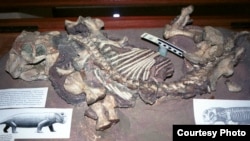The old phrase "live fast, die young" may not be a particularly good personal philosophy, but it could be a winner for species living in hard times — like now.
Land and sea creatures are disappearing at an alarming rate, in what some scientists refer to as the Sixth Mass Extinction. So researchers from the Field Museum in Chicago decided to look back at fossil records to see whether they could find some clues to which animals survived the worst die-off in the planet’s history around 252 million years ago.
At that time, massive volcanic eruptions from Siberia spewed billions of tons of carbon into the atmosphere, radically warming the climate and changing the chemistry of the ocean. Fully 95 percent of marine life and 70 percent of land creatures died in this Third Mass Extinction.
Survivor’s story
One groups of survivors that dominate the fossil record are therapsids, ancient relatives of mammals. Paleontologist Ken Angielczyk and colleagues at the Field Museum did a microscopic analysis of a particular therapsid known as Lystrosaurus.
Before the Third Mass Extinction, Lystrosaurus lived to the ripe old age of 13 or 14 years and grew to about two meters long, the size of a pygmy hippo.
After the extinction, at the boundary between the Permian and Triassic geologic periods, Angielczyk said — the bones tell a new story. Lystrosaurus specimens are then only one or two years old. They seem to have grown rapidly but shrank to the point at which the biggest were only the size of a big dog.
As a survivor in this new world Lystrosaurus bred much younger and spread to all areas of the globe to become the most abundant vertebrate on the planet. Writing in Scientific Reports, Angielczyk said its rapid growth and shorter lifespan increased its chances of survival by 40 percent in the unstable environment.
Today's version
Angielczyk sees a modern version of this live-fast-die-young scenario with the collapse of the Atlantic cod, which have been historically overfished, most recently in industrial-scale operations. Early records show cod lived between 10 and 15 years, with the oldest producing the most offspring.
These days, he said, most cod are younger and tend to breed earlier.
"So we see this pattern" Angielczyk said, "where you have lots of young individuals that are struggling to reproduce as early as possible, given the disturbance of fishing, similar to what you see with Lystrosaurus, where they have lots of young individuals that we think are being forced to reproduce as early as they can."
What separates our times from 252 million years ago is that the extinction crisis today can be blamed largely on human activities that promote a warmer climate, polluted environments, invasive species and habitat loss.
But change is change, and Angielczyk said ancient fossil records offer a reference for action.
"The more we learn about mass extinctions," he said, "including the work that we’re doing, it will help us better understand what will be happening in the world around us today, better plan for changes going forward and, hopefully, also help to prevent some extinctions going forward in the modern world."
Angielczyk said that as we move deeper into the Sixth Mass Extinction, Lystrosaurus provides a valuable primer for survival.









